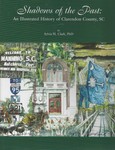


by JERRY ROBERTSON
The years following the War of Independence were difficult, but South Carolina was in better shape than many states. In 1873, a bill was passed dividing Camden District into seven counties, one of which was Sumter-Clarendon. This allowed business transactions and minor legal transgressions to be dealt with on a local basis. Clarendon was separated from Sumter officially on December 19, 1855. The highest officials in the county were Magistrates, some of which were John Canty, John Gamble, William Martin, James Davis, William McConico, Samuel Little and James Lawson. The governmental center was a small settlement near the intersection of Raccoon Road and Oak Grove Church Road and was called Juneville. There was a courthouse and jail of sorts and a few small businesses.
On May 23, 1788, South Carolina became the eighth state to enter the Federal Union known as the United States of America.
There was a strong sentiment for the emancipation of slaves during the revolution. From 1787 until 1801, the South Carolina Assembly passed laws forbidding the importation of slaves. In 1783, William Pearson of Wyboo Swamp gave freedom and a lifetime interest in 20 acres of land to one of his Slaves named Jem, known as Black James Pearson. Black James prospered and later purchased a slave woman named Judy and her two children. In 1791, he emancipated her and the children. This action by Black James may have given the community area in Wyboo its rumored names of Freetown or Pearsontown.
With the advent of the cotton gin, thoughts of emancipation were sidelined. Prior to the invention of the gin, cotton was primarily used to provide clothing for slaves and poor people. Cotton suddenly became a cash crop replacing indigo, livestock and later tobacco as commodity items. Indigo, a major commodity, no longer brought a premium. Coastal farmers relied primarily on slave labor to produce cotton. Midland and upstate farmers used mules and plows for increased efficiency. Few farmers used fertilizer in farming operations and the land became less productive over time. For many, it was simpler to move the farming operation to Alabama or Mississippi rather than use expensive fertilizer, and the importation of slaves continued.
The first federal census of the Clarendon Area in 1790 indicated a population of 2,392 with 602 slaves and did not list any free blacks, likely because many owners purposely did not report their slaves or freemen. Some names appearing on the first (1790) census were Bagnal, Corbett, Eadon, Gamble, Hilton, Plowden, Rigil, Taylor, Thigpen, Tobias, Witherspoon and Woods. By 1800, the census population had grown to 4,374 with 151 free blacks and 2,333 slaves. Then in the 1810 census, the Clarendon area was included in the Sumter District's census and no correct numbers were available until the census of 1860 which showed figures of 13,095, with 8,566 slaves and 152 free blacks.
The War of 1812 had a negative impact on the Clarendon area, both economically and loss of life. In 1820, tariffs imposed on the southern states by the northern states raised concern. South Carolina's concern over the tariffs resulted in the Nullification Ordinance of 1833. Thus began the states' rights debate that led to the Civil War.
This is the third chapter of a continuing chronicle of Clarendon County from its early beginning to its present existence. Much of the information and facts is borrowed from Dr. Sylvia H. Clark's excellent publication "Shadows of the Past," a copy may be purchased at the Clarendon County Archives or the Clarendon County Museum & History Center.